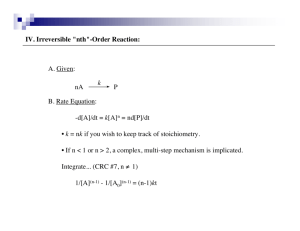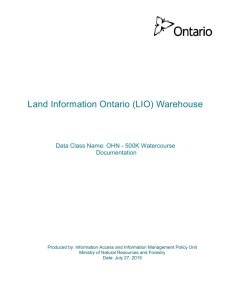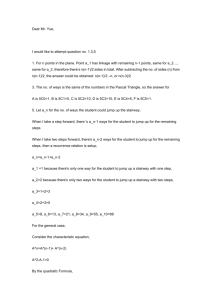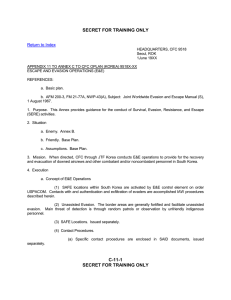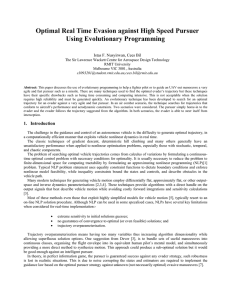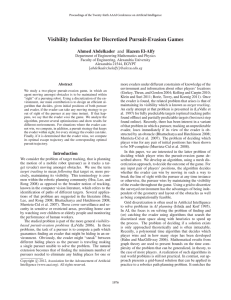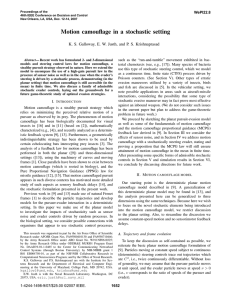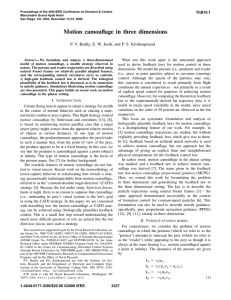Self Stabilization Slides
advertisement
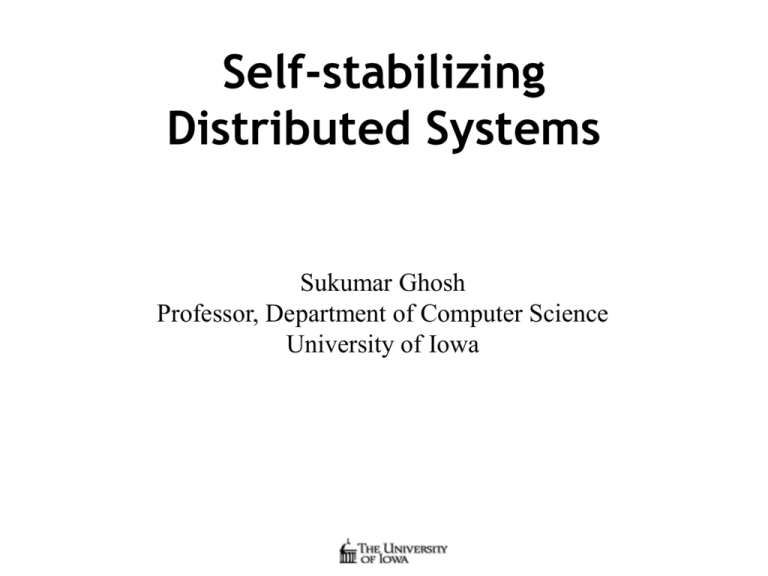
Self-stabilizing
Distributed Systems
Sukumar Ghosh
Professor, Department of Computer Science
University of Iowa
Introduction
2
Failures and Perturbations
Fact 1. All modern distributed systems are dynamic.
Fact 2. Failures and perturbations are a part of such
distributed systems.
Classification of failures
Crash failure
Security failure
Omission failure
Temporal failure
Transient failure
Software failure
Byzantine failure
Environmental perturbations
Classifying fault-tolerance
Masking tolerance.
Application runs as it is. The failure does not have a visible impact.
All properties (both liveness & safety) continue to hold.
Non-masking tolerance.
Safety property is temporarily affected, but not liveness.
Example 1. Clocks lose synchronization, but recover soon thereafter.
Example 2. Multiple processes temporarily enter their critical sections,
but thereafter, the normal behavior is restored.
Backward error-recovery vs. forward error-recovery
Backward vs. forward error recovery
Backward error recovery
When safety property is violated, the computation rolls
back and resumes from a previous correct state.
time
rollback
Forward error recovery
Computation does not care about getting the history right, but
moves on, as long as eventually the safety property is restored.
True for self-stabilizing systems.
So, what is self-stabilization?
• Technique for spontaneous healing after transient
failure or perturbation.
• Non-masking tolerance (Forward error recovery).
• Guarantees eventual safety following failures.
Feasibility demonstrated by Dijkstra in his
Communications of the ACM 1974 article
Why Self-stabilizing systems?
• It is nice to have the ability of spontaneous recovery from any
initial configuration to a legitimate configuration. It implies that
no initialization is ever required. Such systems can be
deployed ad hoc, and are guaranteed to function properly in
bounded time. Such systems restore their functionality without
any extra intervention.
Two properties
It satisfies the following two criteria
. Starting from a bad configuration, every
computation leads to a legitimate configuration
Closure. Once in a legitimate configuration,
continues to be in that configuration, unless there
is another transient failure.
Self-stabilizing systems
State space
legal
10
Example 1:
Self-stabilizing mutual exclusion
on a ring (Dijkstra 1974)
N-1
0
1
2
3
4
5
6
7
Consider a unidirectional ring of processes.
In the legal configuration, exactly one token
will circulate in the network
Stabilizing mutual exclusion on a ring
0
The state of process j is x[j] ∈ {0, 1, 2, K-1}. (Also, K > N)
{Process 0}
repeat x[0] = x[N-1]→ x[0] := x[0] + 1 mod K forever
{Process j > 0} repeat x[j] ≠ x[j -1] → x[j] := x[j-1] forever
(TOKEN = ENABLED GUARD)
Hand-execute this first, before proceeding further.
Start the system from an arbitrary initial configuration
Stabilizing mutual exclusion on a ring
(N=6, K=7)
0
2
5
4
6
0
2
2
5
5
6
0
2
3
3
5
6
6
2
{Process 0}
repeat x[0] = x[N-1]→ x[0] := x[0] + 1 mod K forever
{Process j > 0} repeat x[j] ≠ x[j -1] → x[j] := x[j-1] forever
Outline of Correctness Proof
(Absence of deadlock). If no process j>0 has an enabled guard then
x[0]=x[1]=x[2]= … x[N-1]. But it means that the guard of process 0 is enabled.
(Proof of Closure) In a legal configuration, if a process executes an action,
then its own guard is disabled, and its successor’s guard becomes enabled.
So, the number of tokens (= enabled guards) remains unchanged.
It means that if the system is already in a good configuration, it remains so
(unless, of course a failure occurs)
Correctness Proof (continued)
Proof of Convergence
• Let x be one of the “missing states” in the system.
• Processes 1..N-1 acquire their states from their left neighbor
• Eventually process 0 attains the state x (liveness)
• Thereafter, all processes attain the state x before process 0
becomes enabled again. This is a legal configuration (only
process 0 has a token)
Thus the system is guaranteed to recover from a bad
configuration to a good configuration
To disprove
To prove that a given algorithm is not self-stabilizing to L, it is
sufficient to show that. either
(1) there exists a deadlock configuration, or
(2) there exists a cycle of illegal configurations (≠L) in the history
of the computation, or
(3) The systems stabilizes to a configuration L‘≠ L
Exercise
Consider a completely connected network of n processes numbered
0, 1, …, n-1. Each process i has a variable L(i) that is initialized to i.
The goal of the system is to make the values of all L(i)’s identical:
For this, each process i executes the following algorithm:
repeat
∃j ∈ neighbor (i): L(i) ≠ L(j) → L(i) := L(j)
forever
Question: Is the algorithm self-stabilizing?
Example 2: Clock phase
synchronization
0
System of n clocks ticking at the same rate.
1
2
Each clock is 3-valued, i,e it ticks as 0, 1, 2, 0, 1, 2…
A failure may arbitrarily alter the clock phases.
The clocks phases need to stabilize, i.e.
3
n-1
they need to return to the same phase. .
Design an algorithm for this.
The algorithm
Clock phase synchronization
{Program for each clock}
(c[k] = phase of clock k, initially arbitrary)
repeat
R1. ∃j: j∈ N(i) :: c[j] = c[i] +1 mod 3
c[i] := c[i] + 2 mod 3
R2.
∀k: c[k] ∈ {0.1.2}
0
1
2
∀j: j∈N(i) :: c[j] ≠ c[i] +1 mod 3
c[i] := c[i] + 1 mod 3
forever
First, verify that it “appears to be” correct.
Work out a few examples.
3
n-1
Why does it work?
0
1
2
0
2
2
2
0
1
1
0
1
1
2
2
2
n-1
2
2
Understand the game of arrows
Let D = d[0] + d[1] + d[2] + … + d[n-1]
d[i] = 0 if no arrow points towards clock i;
= i + 1 if a ← points towards clock i;
= n – I if a → points towards clock i;
= 1 if both → and ← point towards
clock i.
By definition, D ≥ 0.
Also, D decreases after every step
in the system. So the number of
arrows must reduce to 0.
Exercise
1. Why 3-valued clocks? What happened for larger
clocks?
2. Will the algorithm work for a ring topology? Why or
why not?
Example 3:
Self-stabilizing spanning tree
Problem description
• Given a connected graph G = (V,E) and a root r,
design an algorithm for maintaining a spanning
tree in presence of transient failures that may corrupt
the local states of processes (and hence the
spanning tree) .
• Let n = |V|
Different scenarios
0
1
2
3
0
1
1
Parent(2) is corrupted
2
3
4
5
5
4
2
4
3
5
Different scenarios
0
1
0
1
1
2
2
3
3
4
5
5
4
1
2
2
5
3
4
5
5
4
The distance variable L(3) is corrupted
Definitions
Each process i has two variables:
L(i) = Distance from the root via tree edges
P(i) = parent of process i
denotes the neighbors of i
By definition L(r) = 0, and P(r) is undefined and 0 ≤ L(i) ≤ n.
In a legal state ∀i ∈ V: i ≠ r:: L(i) ≠ n and L(i) = L(P(i)) +1.
The algorithm
repeat
0
1
R1. (L(i) ≠ n) ∧ (L(i) ≠ L(P(i)) +1)
1
∧ (L(P(i)) ≠ n) L(i) :=L(P(i) + 1
R2. (L(i) ≠ n)∧(L(P(i))=n) L(i):=n
R3. (L(i) =n) ∧ (∃k ∈ N(i):L(k)<n-1)
L(i) :=L(k)+1; P(i):=k
forever
0
2
3
P(2) is corrupted
2
4
3
5
5
4
The blue labels denote
the values of L
Proof of stabilization
Define an edge from i to P(i) to be well-formed, when
L(i) ≠ n, L(P(i)) ≠ n and L(i) = L(P(i)) +1.
In any configuration, the well-formed edges form a
spanning forest. Delete all edges that are not wellformed. Each tree T(k) in the forest is identified by k,
the lowest value of L in that tree.
Example
In the sample graph shown earlier, the original spanning
tree is decomposed into two well-formed trees
T(0) = {0, 1}
T(2) = {2, 3, 4, 5}
Let F(k) denote the number of T(k)’s in the forest.
Define a tuple F= (F(0), F(1), F(2) …, F(n)).
For the sample graph, F = (1, 0, 1, 0, 0, 0) after node 2’s
has a transient failure.
Proof of stabilization
Minimum F = (1,0,0,0,0,0) {legal configuration}
Maximum F = (1, n-1, 0, 0, 0, 0) (considering lexicographic order)
With each action of the algorithm, F decreases lexicographically.
Verify the claim!
This proves that eventually F becomes (1,0,0,0,0,0) and the
spanning tree stabilizes.
What is an upper bound time complexity of this algorithm?
Conclusion
Classical self-stabilization does not allow the codes to
be corrupted. Can we do anything about it?
The fault-containment problem
The concept of transient fault is now quite relaxed.
Such failures now include
-- perturbations (like node mobility in WSN)
-- change in environment
-- change in the scale of systems,
-- change in user demand of resources
The tools for tolerating these are varied, and still evolving.
Questions?
Applications
• Concepts similar to stabilization are present in the
networking area for quite some time. Wireless
sensor networks have given us a new platform.
• Many examples of systems that recover from
limited perturbations. These mostly characterize a
few self-healing and self-organizing systems.
The University of Iowa
32
Pursuer Evader Games
In a disaster zone, rescuers
(pursuers) try to track hot
spots (evaders) using sensor
networks. How soon can the
pursuers catch the evader
(Arora, Demirbas, Gouda 2003)
The University of Iowa
33
Pursuer Evader Games
• Evader is omniscient;
• Strategy of evader is unknown
• Pursuer can only see state of
nearest node;
• Pursuer moves faster than evader
• Design a program for nodes and
pursuer so that itr can catch evader
(despite the occurrence of faults)
The University of Iowa
34
Main idea
A balanced tree (DFS) is continuously
maintained with the evader as the root. The
pursuer climbs “up the tree” to reach the
evader.
The University of Iowa
35


